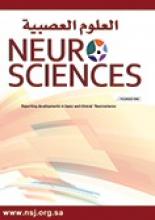Abstract
OBJECTIVE: To study the effect of rheumatoid arthritis (RA) on the temporomandibular joints (TMJ) and related muscles using CT scan and neurophysiologic tests.
METHODS: Forty-two RA patients referred from the Maxillofacial Clinic at the Special Surgeries Hospital, Medical City, Baghdad, Iraq from February 2006 to September 2006 were included in this study. Thirty-seven of them underwent CT scan of the TMJ and 25 of these patients were neurophysiologically examined. The data were compared to 30 age-matched control subjects.
RESULTS: Fifteen patients showed normal TMJ, whereas, abnormal TMJ on CT scan was present in 22 patients. Of these 22 patients, 6 showed decrease in the intra-articular space, 6 exhibited erosion of the condylar head, and 3 had flattening of the condylar head. The remaining 7 patients had all the abnormalities present. Electromyography (EMG) examination showed reduced interference pattern, poor recruitment of motor unit potentials, shift of the power spectra to the lower frequencies, low mean power frequency, and root mean square values, and prolonged blink reflex component latencies.
CONCLUSION: Rheumatoid arthritis patients with positive CT scan findings have poorer neurophysiologic data than those without CT scan detectable lesions. Trigeminal motor neuropathy is suggested to be the cause of the masticatory muscle weakness. Root mean square voltage as a parameter of the EMG power spectra is of great value in diagnosing such weakness.
- Copyright: © Neurosciences
Neurosciences is an Open Access journal and articles published are distributed under the terms of the Creative Commons Attribution-NonCommercial License (CC BY-NC). Readers may copy, distribute, and display the work for non-commercial purposes with the proper citation of the original work.






